Related Research Articles

The blue whale is a marine mammal belonging to the baleen whale parvorder Mysticeti. Reaching a maximum confirmed length of 29.9 metres (98 ft) and weighing up to 199 tonnes, it is the largest animal known to have ever existed. The blue whale's long and slender body can be various shades of greyish-blue dorsally and somewhat lighter underneath.

Whaling is the process of hunting of whales for their usable products such as meat and blubber, which can be turned into a type of oil that became increasingly important in the Industrial Revolution. It was practiced as an organized industry as early as 875 AD. By the 16th century, it had risen to be the principal industry in the coastal regions of Spain and France. The industry spread throughout the world, and became increasingly profitable in terms of trade and resources. Some regions of the world's oceans, along the animals' migration routes, had a particularly dense whale population, and became the targets for large concentrations of whaling ships, and the industry continued to grow well into the 20th century. The depletion of some whale species to near extinction led to the banning of whaling in many countries by 1969, and to a worldwide cessation of whaling as an industry in the late 1980s.

Whales are a widely distributed and diverse group of fully aquatic placental marine mammals. They are an informal grouping within the infraorder Cetacea, which usually excludes dolphins and porpoises. Whales, dolphins and porpoises belong to the order Cetartiodactyla, which consists of even-toed ungulates. Their closest non-cetacean living relatives are the hippopotamuses, from which they and other cetaceans diverged about 54 million years ago. The two parvorders of whales, baleen whales (Mysticeti) and toothed whales (Odontoceti), are thought to have had their last common ancestor around 34 million years ago. Whales consist of eight extant families: Balaenopteridae, Balaenidae, Cetotheriidae, Eschrichtiidae, Monodontidae, Physeteridae, Kogiidae, and Ziphiidae.
The International Whaling Commission (IWC) is an international body established under the terms of the 1946 International Convention for the Regulation of Whaling (ICRW) to "provide for the proper conservation of whale stocks and thus make possible the orderly development of the whaling industry".

Baleen whales, also known as whalebone whales, are a parvorder of carnivorous marine mammals of the infraorder Cetacea which use keratinaceous baleen plates in their mouths to sieve planktonic creatures from the water. Mysticeti comprises the families Balaenidae, Balaenopteridae, and Cetotheriidae. There are currently 16 species of baleen whales. While cetaceans were historically thought to have descended from mesonychids, molecular evidence instead supports them as a clade of even-toed ungulates (Artiodactyla). Baleen whales split from toothed whales (Odontoceti) around 34 million years ago.

The minke whale, or lesser rorqual, is a species complex of baleen whale. The two species of minke whale are the common minke whale and the Antarctic minke whale. The minke whale was first described by the Danish naturalist Otto Fabricius in 1780, who assumed it must be an already known species and assigned his specimen to Balaena rostrata, a name given to the northern bottlenose whale by Otto Friedrich Müller in 1776. In 1804, Bernard Germain de Lacépède described a juvenile specimen of Balaenoptera acuto-rostrata. The name is a partial translation of Norwegian minkehval, possibly after a Norwegian whaler named Meincke, who mistook a northern minke whale for a blue whale.
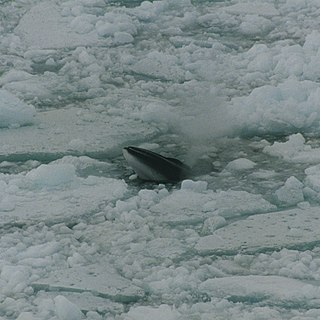
The Antarctic minke whale or southern minke whale is a species of minke whale within the suborder of baleen whales. It is the second smallest rorqual after the common minke whale and the third smallest baleen whale. Although first scientifically described in the mid-19th century, it was not recognized as a distinct species until the 1990s. Once ignored by the whaling industry due to its small size and low oil yield, the Antarctic minke was able to avoid the fate of other baleen whales and maintained a large population into the 21st century, numbering in the hundreds of thousands. Surviving to become the most abundant baleen whale in the world, it is now one of the mainstays of the industry alongside its cosmopolitan counterpart the common minke. It is primarily restricted to the Southern Hemisphere and feeds mainly on euphausiids.

Whale watching is the practice of observing whales and dolphins (cetaceans) in their natural habitat. Whale watching is mostly a recreational activity, but it can also serve scientific and/or educational purposes. A study prepared for International Fund for Animal Welfare in 2009 estimated that 13 million people went whale watching globally in 2008. Whale watching generates $2.1 billion per annum in tourism revenue worldwide, employing around 13,000 workers. The size and rapid growth of the industry has led to complex and continuing debates with the whaling industry about the best use of whales as a natural resource.

Right whales or black whales are three species of large baleen whales of the genus Eubalaena: the North Atlantic right whale, the North Pacific right whale and the Southern right whale. They are classified in the family Balaenidae with the bowhead whale. Right whales have rotund bodies with arching rostrums, V-shaped blowholes and dark gray or black skin. The most distinguishing feature of a right whale is the rough patches of skin on its head, which appear white due to parasitism by whale lice. Right whales can grow up to more than 18 m (59 ft) long with a highest-recorded length of 19.8 m (65 ft). Right whales are very robust whales, weighing 100 short tons or more. The largest known right whales can attain 20.7 m (68 ft) in length and weigh up to 135,000 kg (298,000 lb). Specimens measuring 21.3 m (70 ft) and weighing 150,000 kg (330,000 lb) are documented in whaling records but not scientifically confirmed. Their immense bulk makes right whales significantly heavier than other whales of similar or greater length such as the humpback, gray, sperm and even fin whales. In fact, right whales rank only behind the blue whale in sheer body mass. One (apocryphal) explanation for their name is that whalers identified them as the "right" whale to kill on a hunt due to the plentiful oil and baleen they could provide.
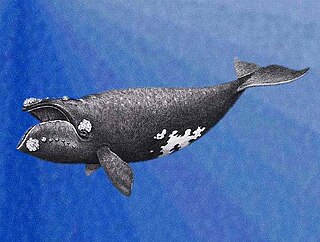
The North Pacific right whale is a very large, thickset baleen whale species that is extremely rare and endangered.

Indigenous whaling is the hunting of whales by indigenous peoples recognised by either IWC or the hunting is considered as part of indigenous activity by the country. It is permitted under international regulation, but in some countries remains a contentious issue. It is usually considered part of the subsistence economy. In some places whaling has been superseded by whale watching instead. This article deals with communities that continue to hunt; details about communities that have ended the practice may be found at History of whaling.

Japanese whaling, in terms of active hunting of whales, is estimated by the Japan Whaling Association to have begun around the 12th century. However, Japanese whaling on an industrial scale began around the 1890s when Japan started to participate in the modern whaling industry, at that time an industry in which many countries participated. Modern Japanese whaling activities have extended far outside Japanese territorial waters, including whale sanctuaries protected by other countries.
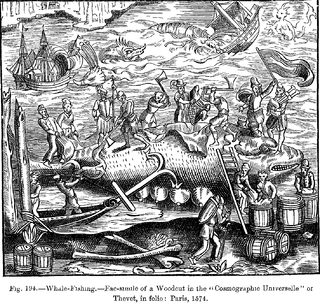
This article discusses the history of whaling from prehistoric times up to the commencement of the International Whaling Commission (IWC) moratorium on commercial whaling in 1986. Whaling has been an important subsistence and economic activity in multiple regions throughout human history. Commercial whaling dramatically reduced in importance during the 19th century due to the development of alternatives to whale oil for lighting, and the collapse in whale populations. Nevertheless, some nations continue to hunt whales even today.

A whaler or whaling ship is a specialized vessel, designed or adapted for whaling: the catching or processing of whales.
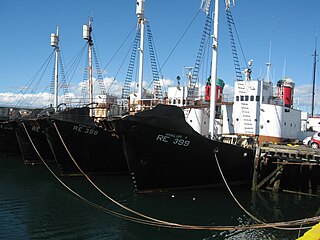
Whaling in Iceland began with spear-drift hunting as early as the 12th century, and continued in a vestigial form until the late 19th century, when other countries introduced modern commercial practices. Today, Iceland is one of a handful of countries that formally object to an ongoing moratorium established by the International Whaling Commission in 1986, and that still maintain a whaling fleet. One company remains concentrated on hunting fin whales, largely for export to Japan, while the only other one previously hunted minke whales for domestic consumption until 2020, as the meat was popular with tourists. In 2018, Icelandic whalers were accused of slaughtering a blue whale. Whaling has been temporarily paused in Iceland since 2019 as coronavirus restrictions, competition from subsidized Japanese whaling, and increasing domestic whale watching tourism have hampered the industry. It is uncertain if commercial whaling will resume in 2022.
Whaling in Norway involves hunting of minke whales for use as animal and human food in Norway and for export to Japan. Whale hunting has been a part of Norwegian coastal culture for centuries, and commercial operations targeting the minke whale have occurred since the early 20th century. Some still continue the practice in the modern day.
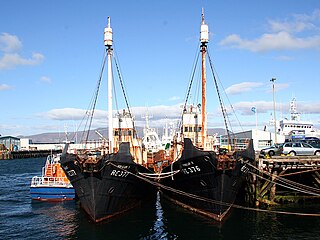
The 1986 Hvalur sinkings occurred in Iceland's Reykjavík harbour in November 1986, when anti-whaling activists from the Sea Shepherd Conservation Society sank the unoccupied whaling vessels, Hvalur 6 and Hvalur 7, and sabotaged a whale processing station in Hvalfjörður. The ships were two of the nation's fleet of four and were eventually raised, but have not gone on a whale hunt since and were dragged onto dry land. Repairs have not yet been made to the ships. The factory was the country's only processing facility.
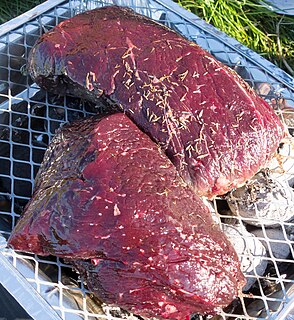
Whale meat, broadly speaking, may include all cetaceans and all parts of the animal: muscle (meat), organs (offal), skin (muktuk), and fat (blubber). There is relatively little demand for whale meat, compared to farmed livestock. Commercial whaling, which has faced opposition for decades, continues today in very few countries, despite whale meat being eaten across Western Europe and colonial America previously. However, in areas where dolphin drive hunting and aboriginal whaling exist, marine mammals are eaten locally as part of a subsistence economy: the Faroe Islands, the circumpolar Arctic, other indigenous peoples of the United States, St. Vincent and the Grenadines, some of villages in Indonesia and in certain South Pacific islands.

Whale conservation refers to the conservation of whales.
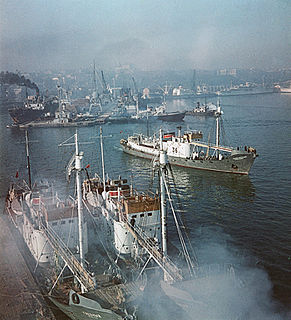
Russian whaling has been conducted by native peoples in the Chukotka region of Russia since at least 4,000 years ago by native Yupik and Chukchi people, but commercial whaling did not begin until the mid-19th century, when companies based in Finland sent out vessels to the Pacific. It was not until 1932 that modern pelagic whaling began to take off with the purchase of an American cargo ship which was renamed the Aleut, which was the only Soviet factory ship until World War II. After the war, with the need for a stronger Soviet economy and rapid industrialization of the country during the 1940s and 1950s, Soviet whaling took off and became a truly global industry. The first Soviet whalers reached the Antarctic during the 1946–47 season with the factory ship Slava and then underwent a rapid expansion during the late 1950s in which 5 new fleets were added within a 4-year span: Sovetskaya Ukraina in 1959, Yuriy Dolgorukiy in 1960, and Sovetskaya Rossiya in 1961 for the Antarctic, and finally two large fleets in 1963 for the North Pacific. Thus, by the early 1960s Soviet whaling had truly become a global industry, operating in every ocean except the North Atlantic and undertaking voyages that could last as long as seven months each. From 1964 to 1973, the Soviet Union was considered by some the biggest whaling nation in the world.
References
- ↑ Burnett, D. Graham (2012). The Sounding of the Whale: Science and Cetaceans in the Twentieth Century . University of Chicago Press. ISBN 978-0226081304.
- ↑ Gulland, J.A. "Fisheries Management and the Limitations of Fishing". Food and Agricultural Organization of the United Nations. Retrieved 24 June 2012.